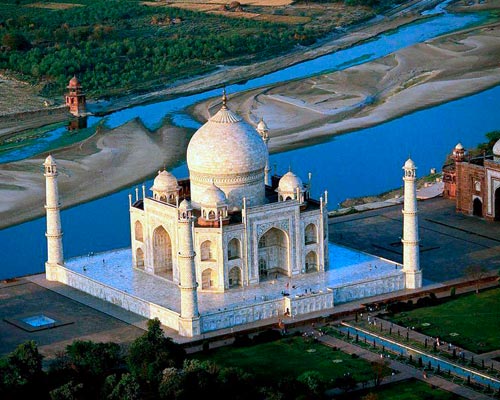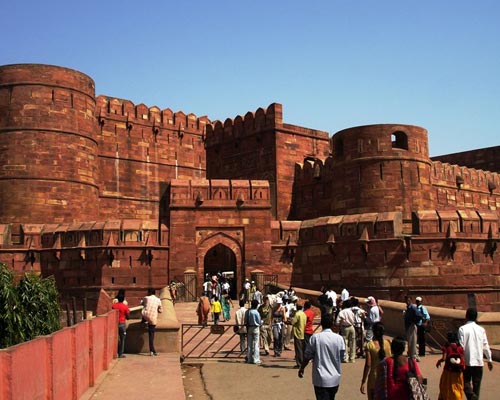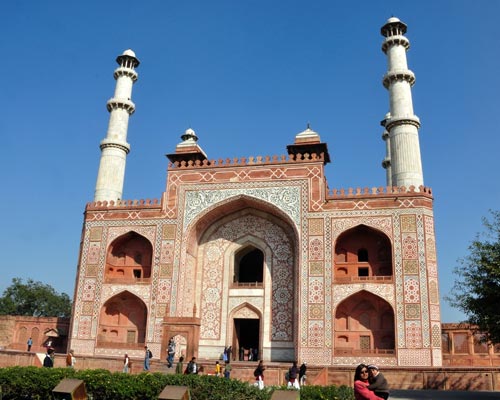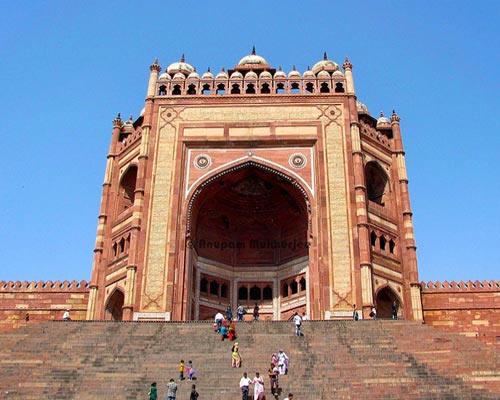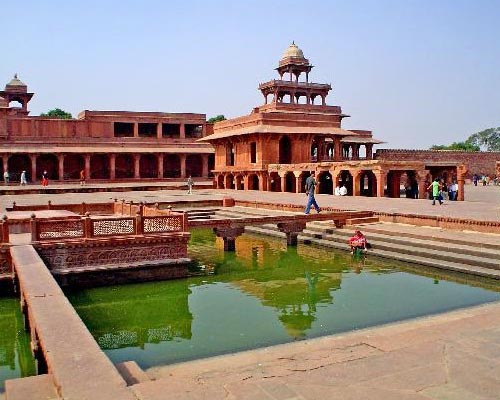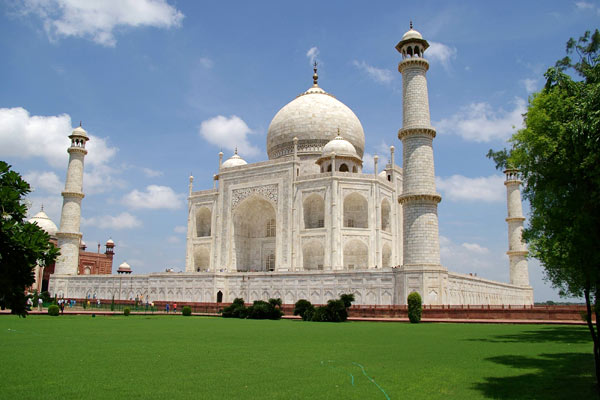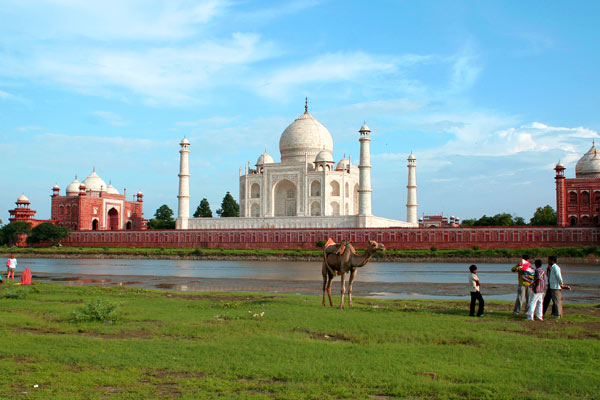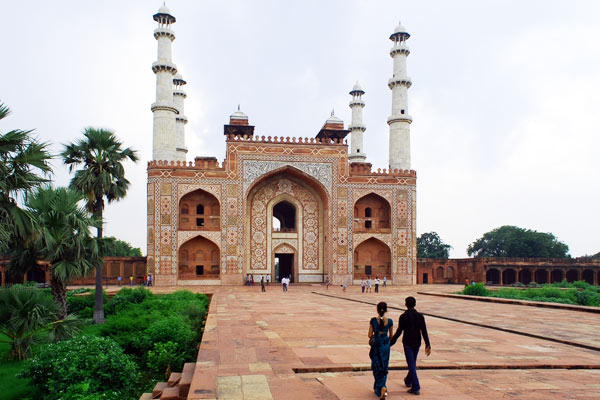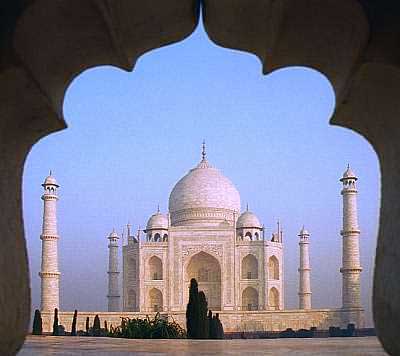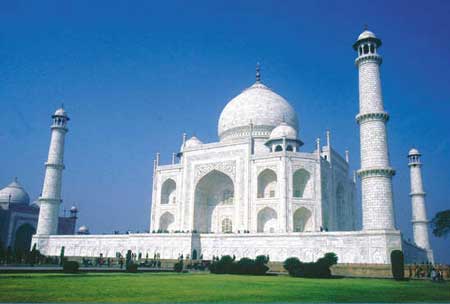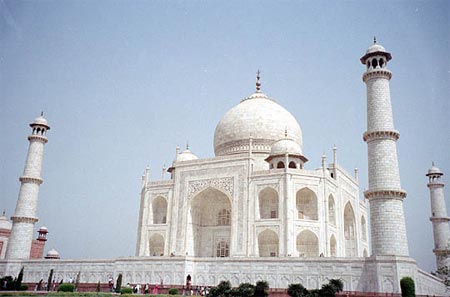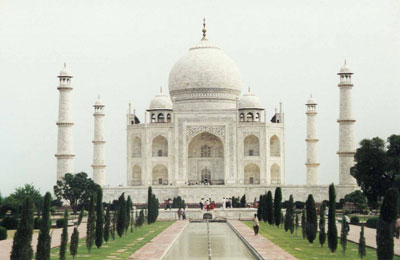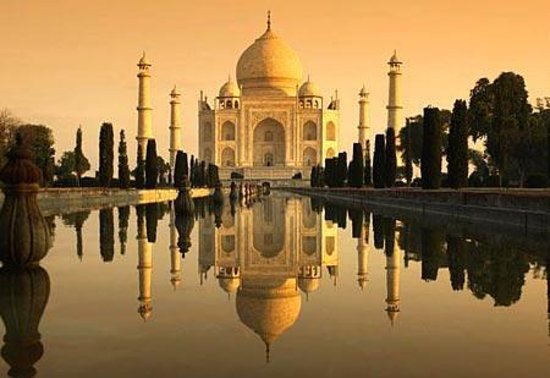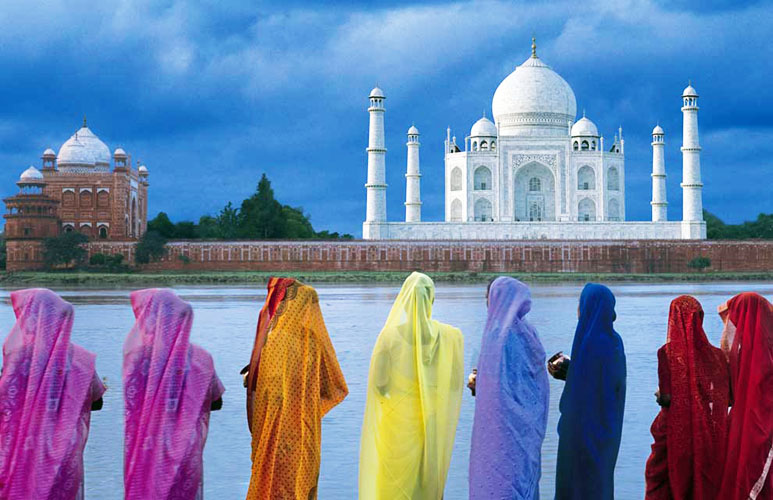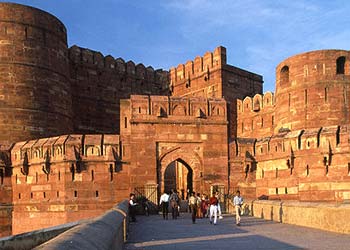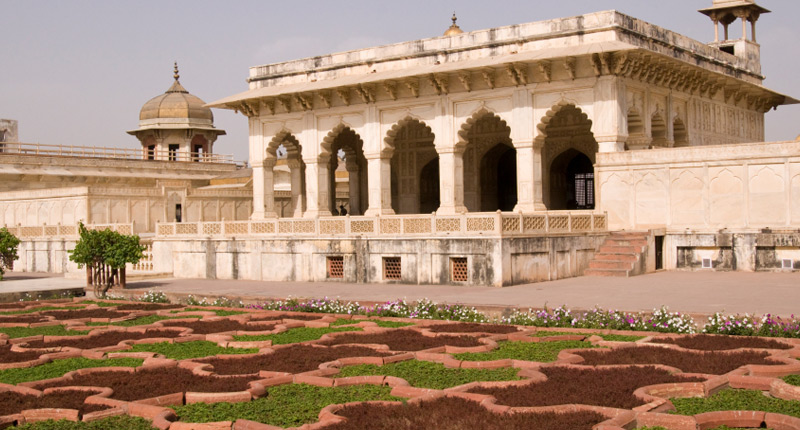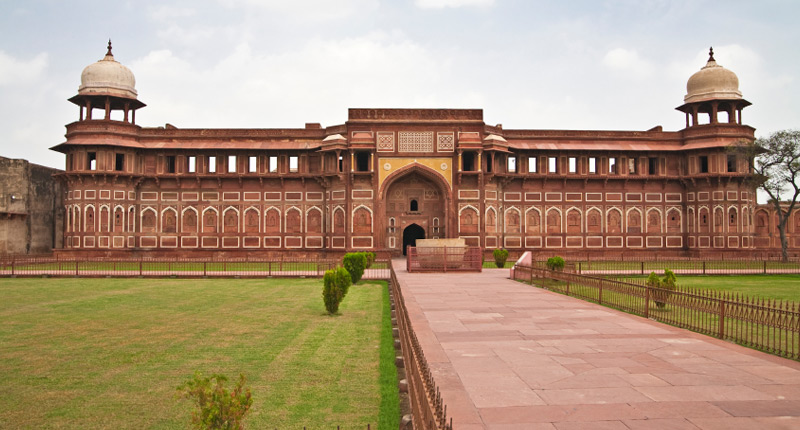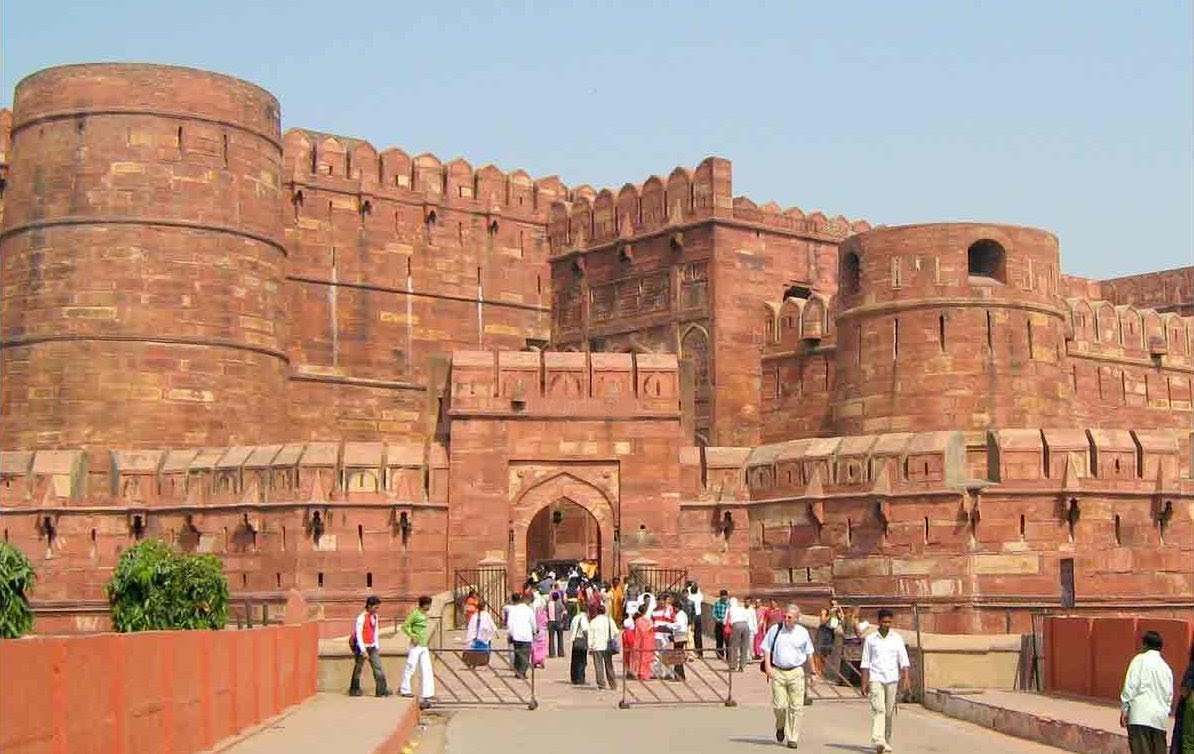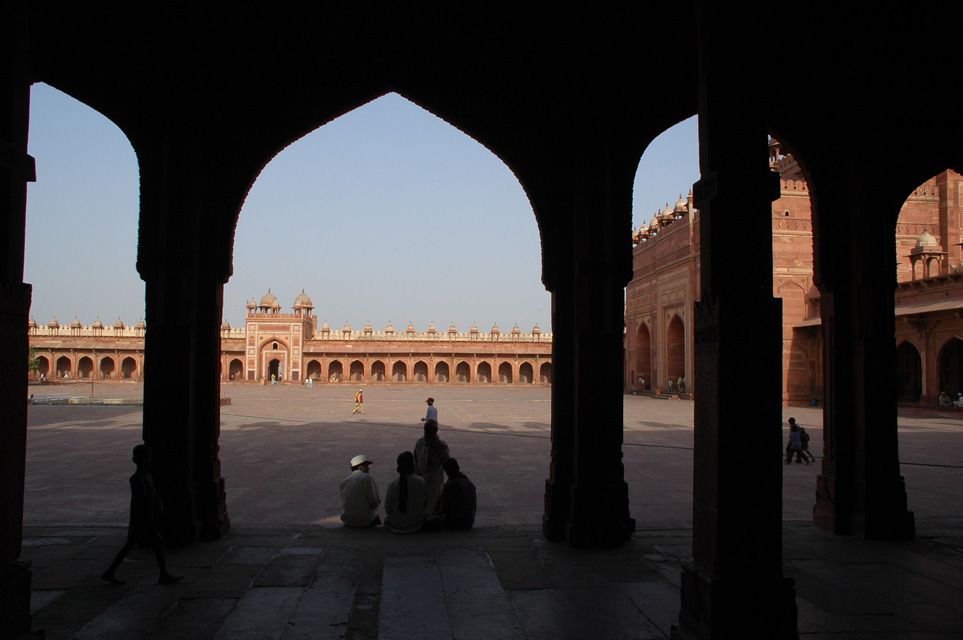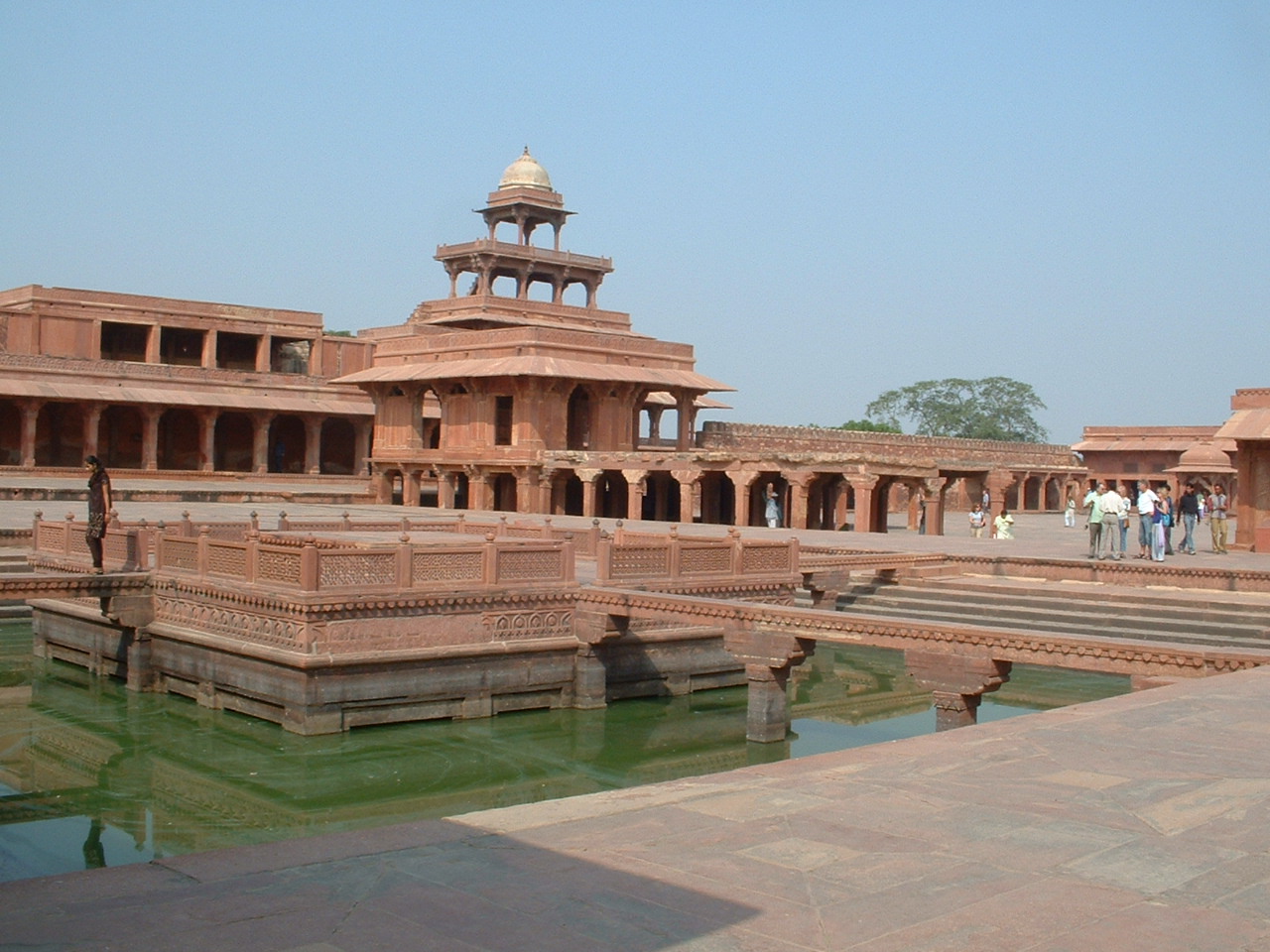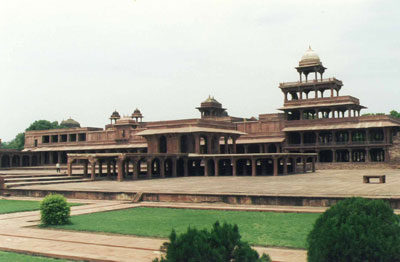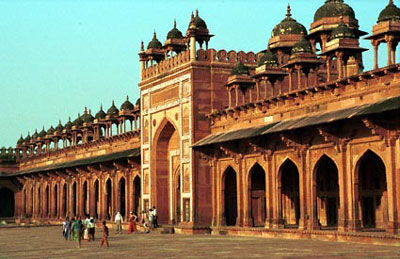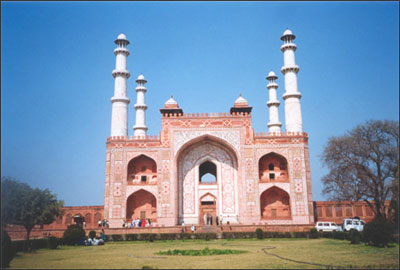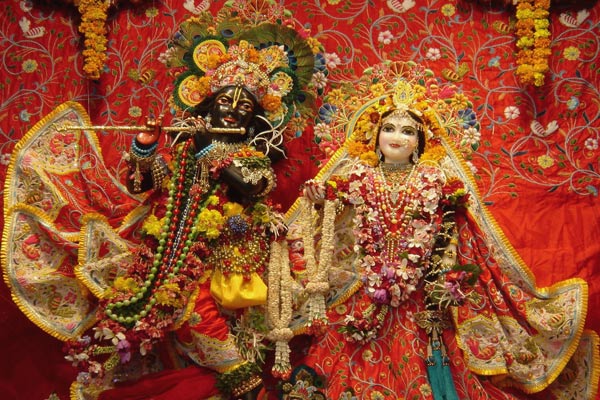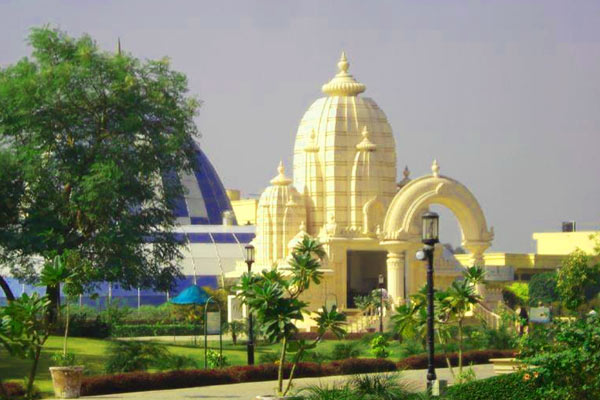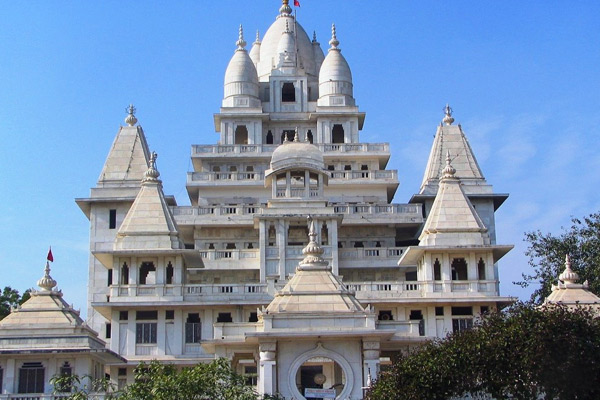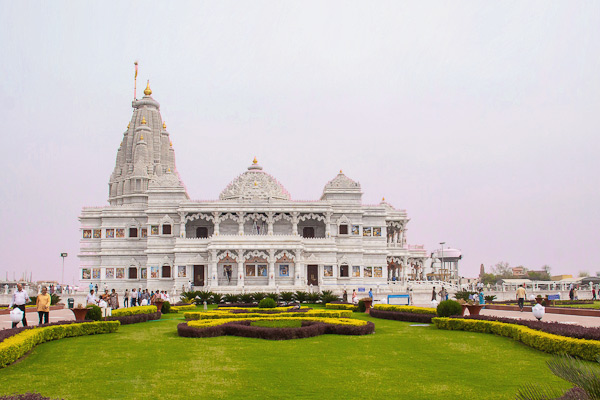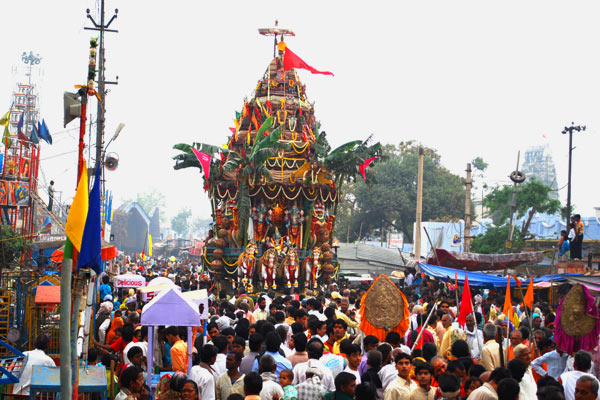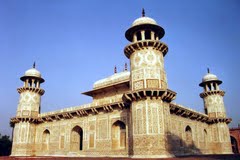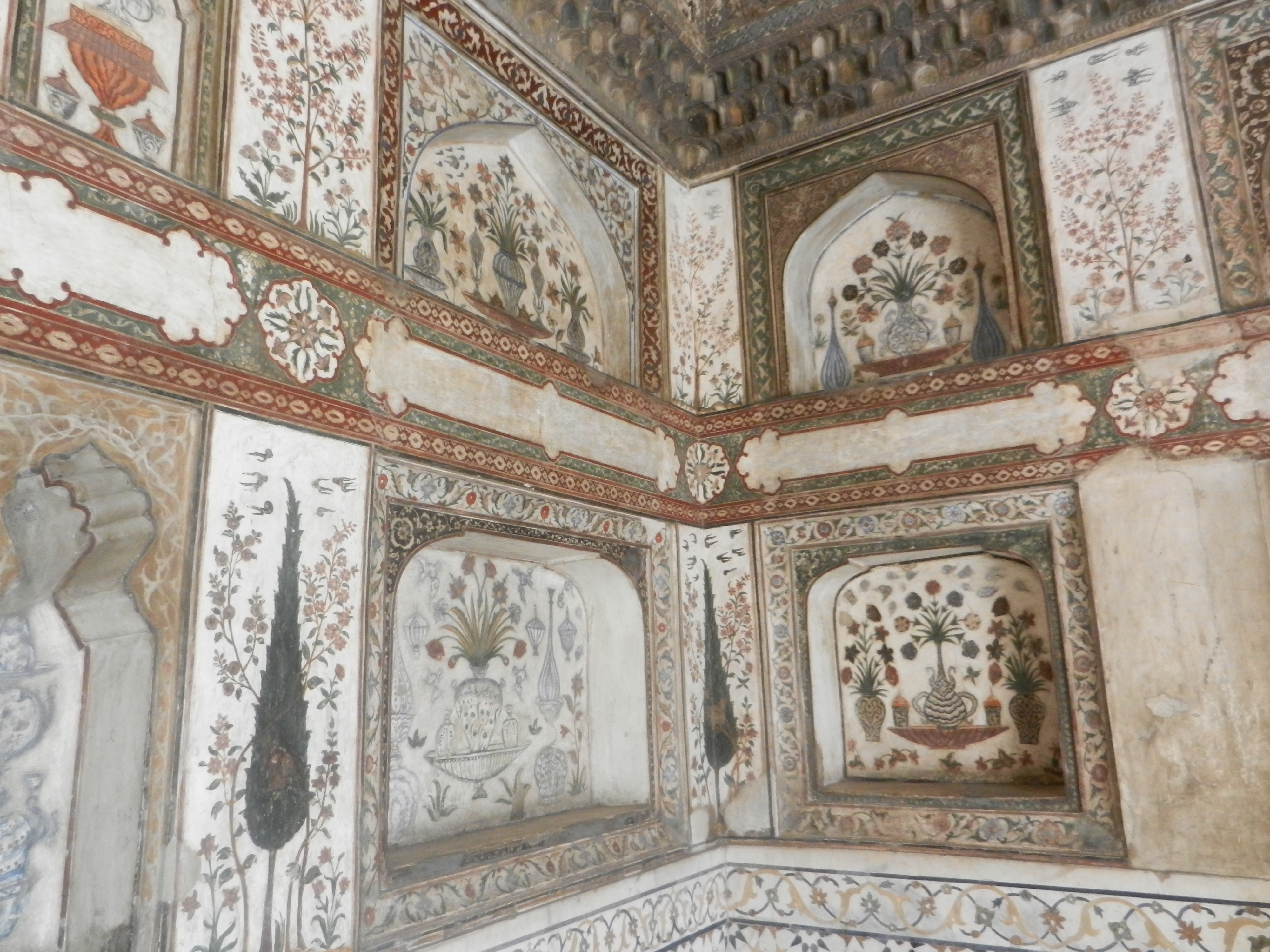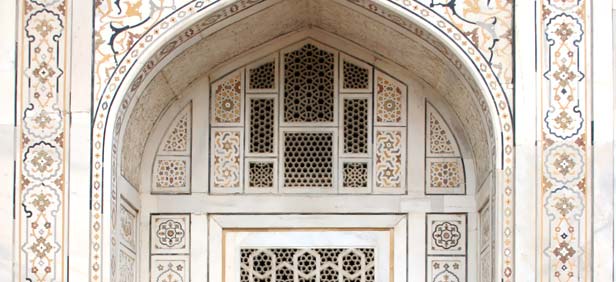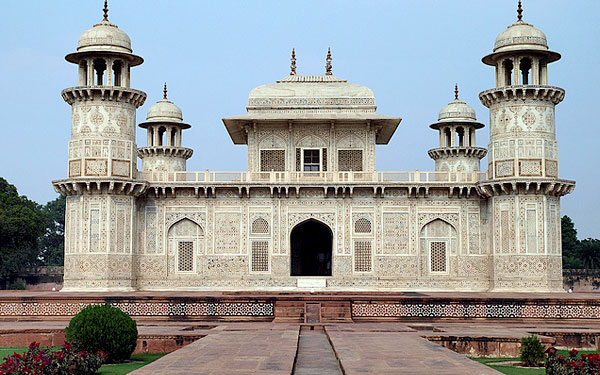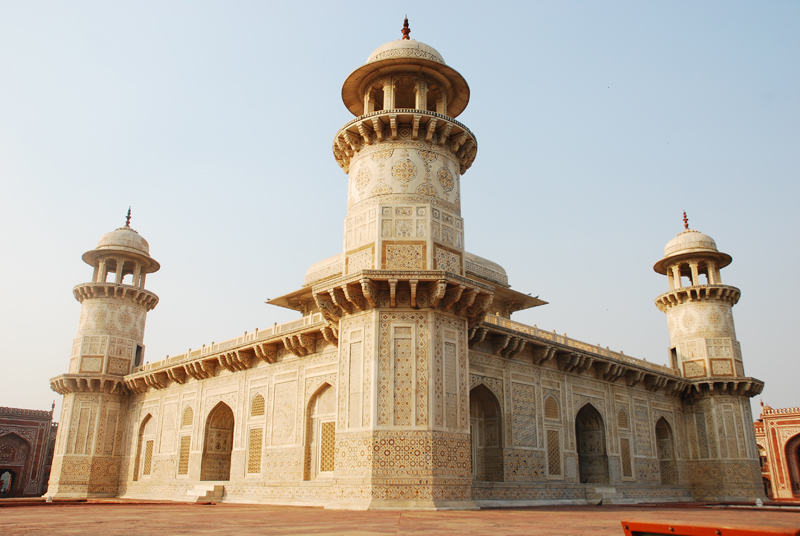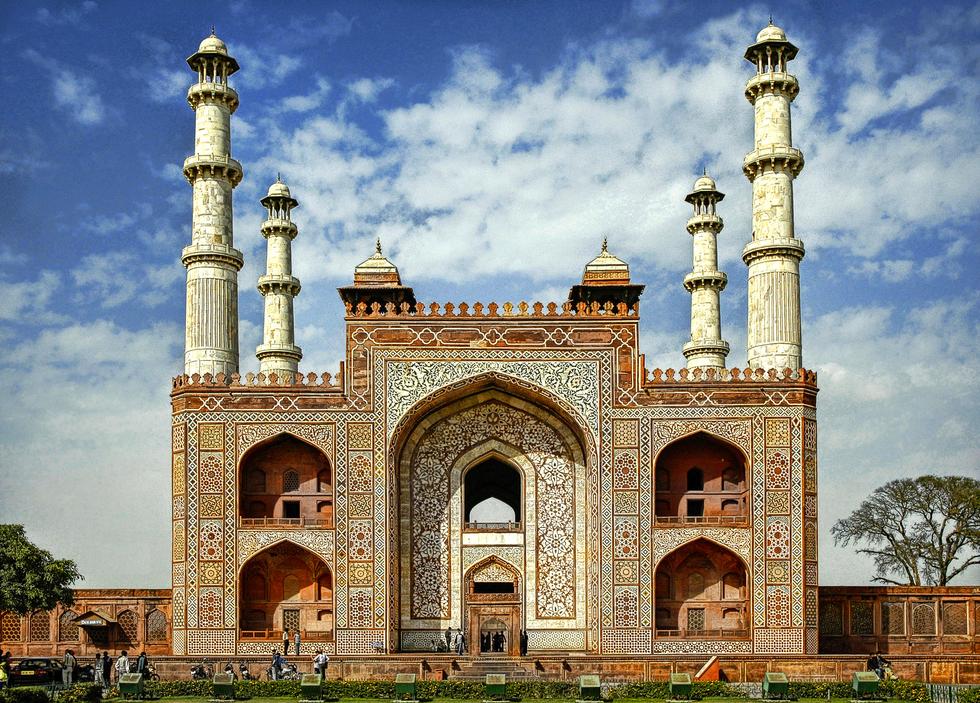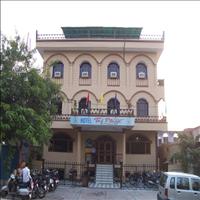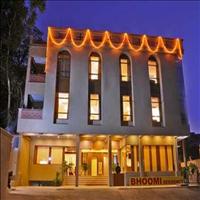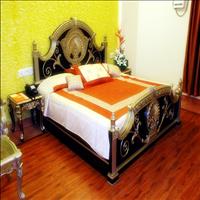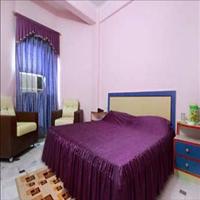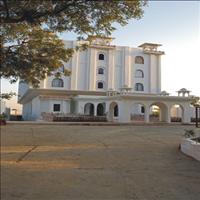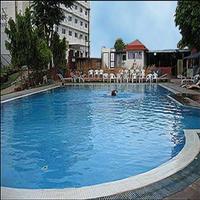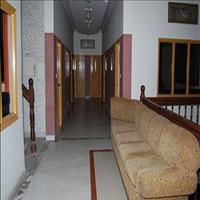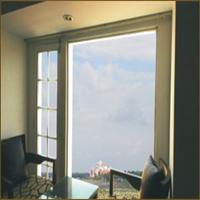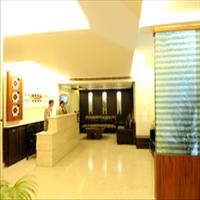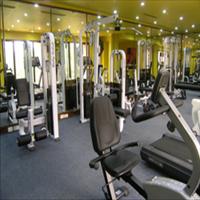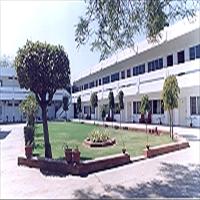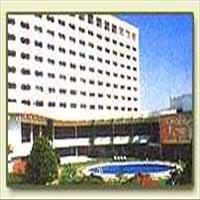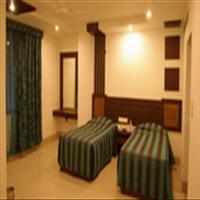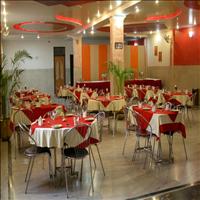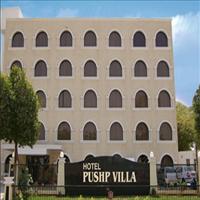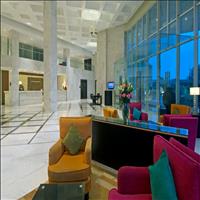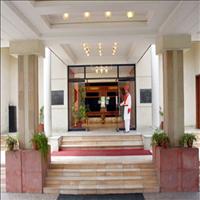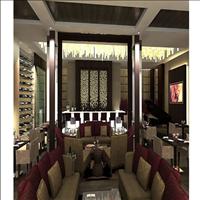Agra
The City of the Taj Mahal
General Information
District: Agra, State: Uttar Pradesh, India
Area: 62 Sq. Km.
Languages Spoken: Hindi, English, Urdu
Long Distance Code: +91-562
Importance: City of Taj
Best Time to Visit: October to March and -
International Access: Delhi
Description
Agra…the majestic capital of the Mughals has placed it self in the world map as the most sought after destination in the world. The city of Taj Mahal as it is known to the world, it is also a city of magical splendours and city having the most magnificent monuments in India, standing testimony to its glorious past. The first establishment possibly was some 5,000 years ago. Basically it has a strategic location and therefore the Aryans must have come and settled here then. It finds a mention in the epic of Mahabharata as Agravana, which the say is the origin of the present name Agra. Agravana means Paradise in Sanskrit. Later the city was also referred to as Arya Griha as the place of Aryans. It is also said that the town was founded by the King Ugrasen. But the town rose to prominence from the time that the Muslim rulers established themselves over here.<br>The present city of Agra was founded by Sikandar Lodhi of the Lodhi dynasty. The Lodhis ruled the area till the Mughals seized it in the mid of the 16th century. It was the mighty Babur who laid the foundation of building forts and gardens in this city. The Mughals loved this city and beautified it as per their requirements by building huge forts and lovely and shapely gardens. The architects were specially brought from Persia to construct the dream buildings of every emperor. <br>Agra remained the seat of almost four Mughal emperors. While Babur settled here, Humayun and Akbar guarded it and Jehangir and Shahajehan beautified it. It remained the capital till emperor Shahajehan shifted the capital to Delhi in the later years of his life. But nonetheless, he could not find a better place than Agra to build the great monument, as tribute to his love, the exotic Taj. And till date for tourists all over the world India is synonymous to the great Taj Mahal. <br>But there is more to Agra than only the Taj. Not only other huge edifices that dot the town, but also something to satisfy the connoisseur for good things in life. Agra is the birth place of the Tandoor cuisine that is famous all over the world. Another famous item of Agra is the sweet prepared of white pumpkin called petha. The spicy snack of dal moth is also tasty. <br>Under the patronage of the Mughal rulers many arts and craft forms were encouraged which still form the handicraft industry of Agra. Brass ware, embroidered clothes, marble curios, intricately designed jewellery and the original Persian carpets are few of the things which can be carried from Agra..Location
Agra is located just 200 kms from Delhi, the capital of India. Situated on the west bank of River Yamuna, Agra was once the flourishing capital of the Muslim rulers of India. It is more than 350 kms away from the state capital of Lucknow and is in the northern plains of India with extreme climate. It is best visited in the winter months of October to March.Climate
Gangetic Belt. In summer hot and humid. in winter dry and sunny but could be cold as well.
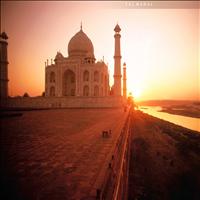 The grandeur called the Taj is perhaps the most photographed, filmed,described and sketched building of the world. Taj Mahal is where fantasy coincides with reality in perfect harmony. An inspiration for innumerous artists over the centuries, the Taj is an ode to love. An epitome of love the world has ever seen which no monument in the world can match. The splendour and the beauty of this pleasant edifice brings one back to experience the magic of this majestic structure. The beauty of the Taj is in its simplicity. It is rare that a person would not fall in love with the pure and simple beauty in white.
The grandeur called the Taj is perhaps the most photographed, filmed,described and sketched building of the world. Taj Mahal is where fantasy coincides with reality in perfect harmony. An inspiration for innumerous artists over the centuries, the Taj is an ode to love. An epitome of love the world has ever seen which no monument in the world can match. The splendour and the beauty of this pleasant edifice brings one back to experience the magic of this majestic structure. The beauty of the Taj is in its simplicity. It is rare that a person would not fall in love with the pure and simple beauty in white.
Emperor Shahajehan had built many an architectural marvels in his career, but Taj Mahal is the zenith. The world heritage site and the seventh architectural wonder of the world, Taj Mahal is different from the rest. The emperor loved his wife Mumtaz dearly. When in 1631, his wife died giving birth to their 14th child; Shahajehan lost the charm to live. It was then he decided to build a mausoleum for his beloved which the world would remember. And indeed Taj Mahal mesmerizes everyone who visits it.
Shahajehan employed best artisans and architects to work on the masterpiece. Finally, 22 years later, with 20,000 workers toiling day and night stood the world's most beautiful monument, and was called the Taj Mahal.
It is said that the world is divided in two parts, people who have seen the Taj and those who have not, such is the glory of this great monument. The subtle beauty of the Taj is the main reason that tourists from all over the world come here, again and again.
The structure of Taj Mahal adheres to the Indo Islamic architecture, which flourished in India during the medieval period. It is said that the structure was based primarily on the structure of Humayun's tomb in Delhi , which was culminated in precision with the building of the Taj.
The mammoth entrance gate built in red sandstone is a beautiful inscribed with texts from the Koran. They are beautifully written in absolutely uniform size from whichever angle you see them. After passing the gate you enter in to the exquisitely laid gardens with symmetrical designs and fountains built in red sandstone with the majestic Taj standing nearly thousand feet away.
The Taj stands atop a plinth with four minarets in each corner. The central dome is huge supported by four smaller domes. The elegantly carved arches and the floral designs, not only intricate, but in perfect symmetry is the highlight of Taj. The exquisite tracery looks more like lace than actual carvings. Earlier precious and semi-precious stones were laid inside the floral designs, a very typical form of craftsmanship known as the pietra dura.
Inside the cenotaph are the two dummy tombs of Shahajehan and his wife Mumtaz; the original ones are in the basement just beneath these. The tombs studded with various precious gems like the Sapphire, Ruby et al were the natural target for grave robbers. The interiors of the chamber have fine floral motifs on in its walls with various shades of marble stones. The most moving feature is the tragic prayer of the emperor which is carved in perfect calligraphy on the tomb which asks for help from the almighty and says,Help us, O Lord, to bear that which we can not bear!
The Taj overlooks the Yamuna and on a quiet day one can hear the water flowing by. As it stands on a raised platform with the blue sky as its backdrop, it gives an impression of a palace floating in the air. The Taj never looks the same at any time and from any angle. The colour of the Taj changes with every change that takes place in the sky. The golden pink Taj at dawn turns into dazzling white at noon. Giving way to the sultry orange at sunset is the milky blue at night. Viewing the Taj on Full moon nights is a blissful experience. The Taj seems to be bathing in the moon light with its fine designs getting illuminated further. The reflections of the Taj in the water pond in front of it or in the Yamuna waters in the back are some of the breath taking views. And actually the life after the Taj is different with a feeling of fulfillment with no blemishes, a feeling of ecstasy having experienced a beautiful monument, a feeling of contentment having viewed the flawless magnificent edifice. It is the most visited attraction in Agra and of India.
Memories abound to cherish and a promise to keep returning to view the Taj in its various moods is what one goes back with from the Taj.
Closed On: Friday
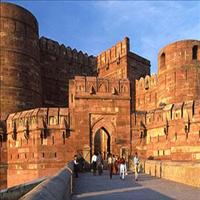 From the sight of it the magnificent structure in Red Sand Stone looks strong and invincible. The common belief goes that it was build by the Mughal emperor Akbar and further developed by his heirs. But in reality the fort was actually a small fortress which a Hindu war lord had built long back around the 5th century viewing the strategic importance of Agra on the banks of River Yamuna.
From the sight of it the magnificent structure in Red Sand Stone looks strong and invincible. The common belief goes that it was build by the Mughal emperor Akbar and further developed by his heirs. But in reality the fort was actually a small fortress which a Hindu war lord had built long back around the 5th century viewing the strategic importance of Agra on the banks of River Yamuna. Later when the Hindu kings and their dynasties were taken over by the Muslim rulers, the small fortress was developed which took the shape of a massive fortress. The Lodhis rebuilt it in the 13th century and Mughal emperor Akbar renovated the Fort in 1565 A.D. Though Akbar built it for military purposes, his heir son Jehangir and grandson Shahajehan turned it into a palatial fort.
The majestic structure is in the area of nearly 3 km and the walls are 20 feet high. It is surrounded by a moat full of water and crocodiles. The fort is built with Red Sand stone and is supposed to be the predecessor of the Red Fort of Delhi. Many buildings inside the fort were built by Shahajehan, unique among which is the stunning pearl mosque. The only building that remains which was built by Akbar is the Jehangiri Mahal, which stands in stark contrast with the rest as it has dominating Hindu architecture. The Diwan - e - Aam and the Diwan - e - Khas are the audience halls built by Shahajehan. The Sheesh Mahal near the Diwan - e - Khas is a beautiful palace with inlaid mirror work on the walls. The Mussaman Burj built by Shahajehan holds significance in the Agra Fort. This octagonal tower built by Shahajehan was supposed to be his bed room. This is also the place where he was detained by his son in his last days. This particular pavilion gives commanding views of the Taj, which the emperor would stare lying on his death bed.
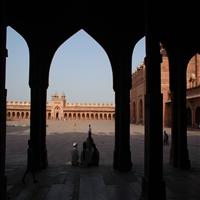 Around 40 km from the main city of Agra stands the ephemeral capital of Emperor Akbar, the Fatehpur Sikri or the city of Victory. Built by Akbar in the 16th century, it is a beautiful city made in brilliant red coloured sand stone that was available around. The city is built on the ridge of a hill within 5 sq. km area, next to a lake which has now dried up. The rapid construction of the city is mysterious and equally mysterious is its desertion. \r\nIt is said that Akbar decided to build a mosque for the Sufi saint Salim Chisti on the spot where it stands now, as a gesture of gratitude. Akbar did not have an heir to his kingdom and after the saint's prophecy he was blessed by three sons. As he started building the palaces, harems, courtyards, pools and places of public and private audience after the construction of the huge mosque and the tomb, his ministers too started building their houses around it; thus constructing a huge city within no time.\r\nBut this beautiful city which was fully operational was deserted soon. The reason for desertion is not clear although it is said to be shortage of water in the royal palaces. Was it a whim of an emperor to build a city and then suddenly leave it or was it his unfulfilled dream, no one knows. A huge gate, known as the Buland Darwaza a unique piece of Mughal architecture, of around 40 meters in height, was constructed after Akbar's victory over Gujarat, which probably gave the city its name of Fatehpur Sikri. The name Buland Darwaza suggests the invincibility of the Fort. \r\nFatehpur Sikri is the amalgamation of many architectural styles. Primarily used are the Gujarat and the Rajput kind of architectures in the construction of its various palaces. The Mosque and especially the tomb of Salim Chisti hold a lot of importance. It is said that if a devotee with whole heartedness prays on the tomb and ties a thread to the carved pane making a wish, his wish definitely gets fulfilled. One can see innumerous threads tied and visitors of all the religions coming over to fulfill their wishes. \r\nThe other important structures on the campus are the Jodhabai Mahal, the Panch Mahal and the Birbal Mahal. All have a distinctive quality of architecture which differs from the rest of the Mughal architecture built during that time. The city also known as the ghost city due to its mysterious abandonment holds a unique charm. Whatever may be the reason of the desertion of the city by the emperor, he definitely left behind one of the finest specimens of architecture of that era.
Around 40 km from the main city of Agra stands the ephemeral capital of Emperor Akbar, the Fatehpur Sikri or the city of Victory. Built by Akbar in the 16th century, it is a beautiful city made in brilliant red coloured sand stone that was available around. The city is built on the ridge of a hill within 5 sq. km area, next to a lake which has now dried up. The rapid construction of the city is mysterious and equally mysterious is its desertion. \r\nIt is said that Akbar decided to build a mosque for the Sufi saint Salim Chisti on the spot where it stands now, as a gesture of gratitude. Akbar did not have an heir to his kingdom and after the saint's prophecy he was blessed by three sons. As he started building the palaces, harems, courtyards, pools and places of public and private audience after the construction of the huge mosque and the tomb, his ministers too started building their houses around it; thus constructing a huge city within no time.\r\nBut this beautiful city which was fully operational was deserted soon. The reason for desertion is not clear although it is said to be shortage of water in the royal palaces. Was it a whim of an emperor to build a city and then suddenly leave it or was it his unfulfilled dream, no one knows. A huge gate, known as the Buland Darwaza a unique piece of Mughal architecture, of around 40 meters in height, was constructed after Akbar's victory over Gujarat, which probably gave the city its name of Fatehpur Sikri. The name Buland Darwaza suggests the invincibility of the Fort. \r\nFatehpur Sikri is the amalgamation of many architectural styles. Primarily used are the Gujarat and the Rajput kind of architectures in the construction of its various palaces. The Mosque and especially the tomb of Salim Chisti hold a lot of importance. It is said that if a devotee with whole heartedness prays on the tomb and ties a thread to the carved pane making a wish, his wish definitely gets fulfilled. One can see innumerous threads tied and visitors of all the religions coming over to fulfill their wishes. \r\nThe other important structures on the campus are the Jodhabai Mahal, the Panch Mahal and the Birbal Mahal. All have a distinctive quality of architecture which differs from the rest of the Mughal architecture built during that time. The city also known as the ghost city due to its mysterious abandonment holds a unique charm. Whatever may be the reason of the desertion of the city by the emperor, he definitely left behind one of the finest specimens of architecture of that era.Closed On: Friday
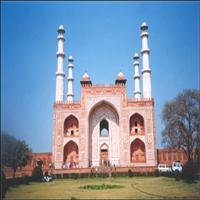 Around 14 kms from Agra is the place where the great emperor of the Mughal dynasty has been put to rest. The Sikandara is Emperor Akbar's mausoleum. It was Akbar who designed his own mausoleum and also had selected the place of the site. The structure and the architecture show the secular characteristic of the great emperor. Both Hindu and Islamic types of architectures are used to build the mausoleum.
Around 14 kms from Agra is the place where the great emperor of the Mughal dynasty has been put to rest. The Sikandara is Emperor Akbar's mausoleum. It was Akbar who designed his own mausoleum and also had selected the place of the site. The structure and the architecture show the secular characteristic of the great emperor. Both Hindu and Islamic types of architectures are used to build the mausoleum. Although Akbar had started building the structure when he was still alive, it was his son and heir of the kingdom, Jehangir who eventually completed after the death of Akbar in 1613 A.D. The beautiful structure has striking inlay work of white marble on red sandstone, and perfect calligraphic ornamentation. The unique pyramidal tomb structure is topped by an open terrace contained within large panels of jail screens. The area where it was built is the gateway or the beginning of the city of Agra which was once ruled by Sikandar Lodhi. Hence it has acquired the name of Sikandara, the last resting place of one of the greatest Emperors of the Mughal dynasty.
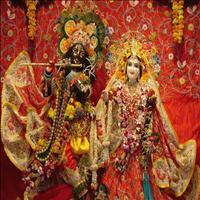 Around 60 kms from Agra on the road to Delhi are the holy twin cities of Mathura and Vrindavan. Associated with the birth place of Lord Krishna, an incarnation of Lord Vishnu, these twin cities are special pilgrimage centers and are thronged by devotees round the year. Mathura, in the ancient days was the nucleus of the Brajbhoomi area.\r\nThe ancient temples, the picturesque Ghats on the bank of River Yamuna, the invocating prayers and songs for the God and the Pedhas, sweets prepared of milk is what Mathura is famous for today.
Around 60 kms from Agra on the road to Delhi are the holy twin cities of Mathura and Vrindavan. Associated with the birth place of Lord Krishna, an incarnation of Lord Vishnu, these twin cities are special pilgrimage centers and are thronged by devotees round the year. Mathura, in the ancient days was the nucleus of the Brajbhoomi area.\r\nThe ancient temples, the picturesque Ghats on the bank of River Yamuna, the invocating prayers and songs for the God and the Pedhas, sweets prepared of milk is what Mathura is famous for today. The Dwarkadheesh temple:
This ancient temple is supposed to be the principal temple of Mathura. Built in 1814 by the treasurer of the Gwalior princely state, Seth Gokuldas Parikh, it has a beautiful idol of the Lord. This is also the most visited temple of Mathura.
The ISCKON temple:
This temple dedicated to Lord Krishna and his elder brother Balaram is structure in pure white build by the followers of the Hare Ram, Hare Krishna group in 1975. One of the most beautiful temples of the sect, this one in Vrindavan is very clean and has beautiful idols of the two deities.
The Jugal Kishore temple:
One of the oldest remaining structures in the area is the Jugal Kishore temple. This temple was built along with four others. It was built in 1627 A.D. but the permission was granted by Emperor Akbar in his visit to the place. The other temples build along with this were the Radharaman temple, the Govindji temple and the Gopinath temple. Most of these temples have lost their old structure in some attack or the original idol has been smuggled away to save it from the wrath. Therefore it is only the Jugal Kishore temple which still stands in the same place and with the original structure and the deity and hence it is considered to be most important one.
Many other temples in Mathura and Vrindavan attract thousands of devotees. Another important aspect of this place is the Ghats. There are around 25 Ghats those were built by various kings and dynasties at various point of time. The important ones among them are the Vishram Ghat and the Kaliya Ghat.
The Vishram Ghat:
According to mythology, Lord Krishna killed his maternal uncle Kansa in Mathura when he was still a young boy. Kansa was an evil man who has imprisoned Krishna’s parents and grandfather and would torture his subjects. After killing the evil man Krishna came and rested at this place on the bank of River Yamuna. So this place is called as the Vishram Ghat or he place to rest.
The Kaliya Ghat:
This Ghat tells the story of Krishna’s childhood who jumped into the river from this place to kill the serpent name Kaliya which was troubling the people of Gokul by poisoning the water.
Apart from these temples there are many other temples dedicated to Radharani, one of the favourite friends of Krishna when he was in Gokul. It is said that the selfless love and devotion of Radha moved Krishna so much that he said that her name will be taken before his whenever people remembered him. Though the two never married, their eternal love and selfless friendship is respected till date. All the temples of Krishna will have an idol of Radharani placed besides the Lord, unlike the other Hindu gods who have their wife along with them.
The Government Museum:
The Government museum is housed in a very beautifully carved buff stone building. Though the museum was opened in the late 19th century by a British, it was shifted to its present position in 1910. The museum has on display many artifacts those were discovered in Mathura itself. The artifacts range through a vast period of time from 5th century B.C. to the 12th century A.D.
The sculptures and coins of the period belonging to the great Kushan dynasty and the Mauryan and Gupta era are on display in this museum. With the most impressive displayable objects, the museum provides perhaps the best material available for the study of Indian Art and Iconography. Probably no other Museum can boast of a better and a more varied collection of archeological material from one single region.
The Raslila dance performance of the Braj area is very famous. This traditional dance form is being performed for ages today. The dance steps are those which are unique to the place and the steps are taken in accordance with the folk songs that accompany them. Normally the Raslila dances are the folk tales and mythological stories based on the life of Krishna, his pranks and his youthful romance with the Gopis and Radharani. Till date the Raslila is performed with much vigour and enthusiasm in the area.
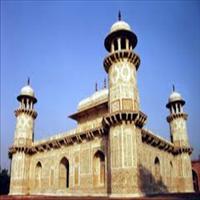 This massive structure in marble is an enchanting piece of Mughal art. Built before the Taj it is supposed to be the first complete marble structure of that period. Itmad ud Daulah or Ghias ud Din Beg was the Prime Minister in the court of Jehangir and also father of Jehangir’s favourite wife Noor Jehan. The tomb was built by Noor Jehan after her father’s death. It took six years to complete and was completed in 1628. Similar to the Taj the whole structure of this tomb is also in marble, with intricate carvings on the window panes and the flower motifs on the walls. The windows have been carved in such a way that the sunlight can directly reach the interiors of the tomb. A similar structure was built by Noor Jehan for her husband Jehangir after his death which today stands in Lahore, Pakistan.
This massive structure in marble is an enchanting piece of Mughal art. Built before the Taj it is supposed to be the first complete marble structure of that period. Itmad ud Daulah or Ghias ud Din Beg was the Prime Minister in the court of Jehangir and also father of Jehangir’s favourite wife Noor Jehan. The tomb was built by Noor Jehan after her father’s death. It took six years to complete and was completed in 1628. Similar to the Taj the whole structure of this tomb is also in marble, with intricate carvings on the window panes and the flower motifs on the walls. The windows have been carved in such a way that the sunlight can directly reach the interiors of the tomb. A similar structure was built by Noor Jehan for her husband Jehangir after his death which today stands in Lahore, Pakistan.
Remarks: Open all days
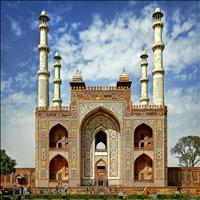 This mausoleum is situated on the out skirts of the Agra City. It houses the mortal remains of the Mughal Emperor Akbar, who, during his lifetime itself had completed the tomb and laid out a beautiful garden. However, the topmost portion of mausoleum in marble was constructed by his son, Jahangir.
This mausoleum is situated on the out skirts of the Agra City. It houses the mortal remains of the Mughal Emperor Akbar, who, during his lifetime itself had completed the tomb and laid out a beautiful garden. However, the topmost portion of mausoleum in marble was constructed by his son, Jahangir.Wonderful Rajasthan with Golden Triangle (MEX) / PC-532 (13 Days / 12 Nights)
Delhi-Agra-Jaipur-Mandawa-Bikaner-Jaisalmer-Jodhpur-Udaipur-Delhi
Rajasthan in the local language means the land of Kings, which Rajathsn actually was once. Now the largest state of India, Rajasthan was dotted with small and big kingdoms all around. The Kings here built beautiful palaces and massive forts as per their needs. Even the traders and the local people of Rajasthan built houses which are worth watching. This fascinating tour will take you to the most exciting of the places in Rajasthan. Combined with Delhi and Agra, it becomes an awesome combination.
Detailed Itinerary
Day 1 : Delhi
Day 2 : Delhi-Agra
Day 3 : Agra - Jaipur
Day 4 : Jaipur
Day 5 : Jaipur-Mandawa
Day 6 : Mandawa-Bikaner
Day 7 : Bikaner-Jaisalmer
Day 8 : Jaisalmer
Day 9 : Jaisalmer-Jodhpur
Day 10 : Jodhpur-Udaipur
Day 11 : Udaipur
Day 12 : Udaipur-Delhi
Day 13 : Delhi
Delhi-Agra-Jaipur-Mandawa-Bikaner-Jaisalmer-Jodhpur-Udaipur-Delhi
Rajasthan in the local language means the land of Kings, which Rajathsn actually was once. Now the largest state of India, Rajasthan was dotted with small and big kingdoms all around. The Kings here built beautiful palaces and massive forts as per their needs. Even the traders and the local people of Rajasthan built houses which are worth watching. This fascinating tour will take you to the most exciting of the places in Rajasthan. Combined with Delhi and Agra, it becomes an awesome combination.
Detailed Itinerary
Day 1 : Delhi
Day 2 : Delhi-Agra
Day 3 : Agra - Jaipur
Day 4 : Jaipur
Day 5 : Jaipur-Mandawa
Day 6 : Mandawa-Bikaner
Day 7 : Bikaner-Jaisalmer
Day 8 : Jaisalmer
Day 9 : Jaisalmer-Jodhpur
Day 10 : Jodhpur-Udaipur
Day 11 : Udaipur
Day 12 : Udaipur-Delhi
Day 13 : Delhi
Incredible Escape Taj Hotel / PC-536 (6 Days / 5 Nights)
Delhi-Agra-Jaipur-Delhi
India with Taj Group of Hotels. It is incredible. It is an escape to luxuary and this holiday i specially cerated by Taj Group of Hotels for you only!
Detailed Itinerary
Day 1 : Delhi
Day 2 : Delhi-Agra
Day 3 : Agra - Jaipur
Day 4 : Jaipur
Day 5 : Jaipur-Delhi
Day 6 : Delhi
Delhi-Agra-Jaipur-Delhi
India with Taj Group of Hotels. It is incredible. It is an escape to luxuary and this holiday i specially cerated by Taj Group of Hotels for you only!
Detailed Itinerary
Day 1 : Delhi
Day 2 : Delhi-Agra
Day 3 : Agra - Jaipur
Day 4 : Jaipur
Day 5 : Jaipur-Delhi
Day 6 : Delhi
Mesmerizing India tour / PC-558 (12 Days / 11 Nights)
Mumbai-Delhi-Ajmer-Jaipur-Bharatpur-Agra-Aligarh-Lucknow-Delhi
India is a land of diversity. Yet, it has a huge Islamic population intermingled with the existing core culture. Indian history is replete with the cultural and ethical interactions that happened between South East Asia Islamic and pre-existing socio-cultural groups. This tour takes you around the roots and various expressions of South-East Asian Islamic Institutes and their influence in Society.
Detailed Itinerary
Day 1 : Mumbai
Day 2 : Mumbai-Delhi
Day 3 : Delhi
Day 4 : Delhi-Ajmer
Day 5 : Ajmer
Day 6 : Ajmer-Jaipur
Day 7 : Jaipur-Bharatpur
Day 8 : Bharatpur-Agra
Day 9 : Agra
Day 10 : Agra-Aligarh
Day 11 : Aligarh-Lucknow
Day 12 : Lucknow-Delhi
Mumbai-Delhi-Ajmer-Jaipur-Bharatpur-Agra-Aligarh-Lucknow-Delhi
India is a land of diversity. Yet, it has a huge Islamic population intermingled with the existing core culture. Indian history is replete with the cultural and ethical interactions that happened between South East Asia Islamic and pre-existing socio-cultural groups. This tour takes you around the roots and various expressions of South-East Asian Islamic Institutes and their influence in Society.
Detailed Itinerary
Day 1 : Mumbai
Day 2 : Mumbai-Delhi
Day 3 : Delhi
Day 4 : Delhi-Ajmer
Day 5 : Ajmer
Day 6 : Ajmer-Jaipur
Day 7 : Jaipur-Bharatpur
Day 8 : Bharatpur-Agra
Day 9 : Agra
Day 10 : Agra-Aligarh
Day 11 : Aligarh-Lucknow
Day 12 : Lucknow-Delhi
Tour the Exotic land, India / PC-562 (16 Days / 15 Nights)
Delhi-Agra-Jaipur-Samode-Pushkar-Udaipur-Mumbai-Kochi-Alappuzha-Thiruvananthapuram-Kovalam-Thiruvananthapuram-Delhi
A journey starting from the north and ending in south of India. Each place comes as a surprise, each destination fascinates you equally. The mystic India comes alive on this tour. The beauty and the royalty come face to face in this mesmerizing tour of exotic India.
Detailed Itinerary
Day 1 : Delhi
Day 2 : Delhi
Day 3 : Delhi-Agra
Day 4 : Agra-Jaipur
Day 5 : Jaipur
Day 6 : Jaipur-Samode
Day 7 : Samode-Pushkar
Day 8 : Pushkar-Udaipur
Day 9 : Udaipur
Day 10 : Udaipur-Mumbai-Kochi
Day 11 : Kochi - Alappuzha
Day 12 : Alappuzha - Thiruvananthapuram-Kovalam
Day 13 : Kovalam
Day 14 : Kovalam
Day 15 : Kovalam-Thiruvananthapuram-Delhi
Day 16 : Delhi
Delhi-Agra-Jaipur-Samode-Pushkar-Udaipur-Mumbai-Kochi-Alappuzha-Thiruvananthapuram-Kovalam-Thiruvananthapuram-Delhi
A journey starting from the north and ending in south of India. Each place comes as a surprise, each destination fascinates you equally. The mystic India comes alive on this tour. The beauty and the royalty come face to face in this mesmerizing tour of exotic India.
Detailed Itinerary
Day 1 : Delhi
Day 2 : Delhi
Day 3 : Delhi-Agra
Day 4 : Agra-Jaipur
Day 5 : Jaipur
Day 6 : Jaipur-Samode
Day 7 : Samode-Pushkar
Day 8 : Pushkar-Udaipur
Day 9 : Udaipur
Day 10 : Udaipur-Mumbai-Kochi
Day 11 : Kochi - Alappuzha
Day 12 : Alappuzha - Thiruvananthapuram-Kovalam
Day 13 : Kovalam
Day 14 : Kovalam
Day 15 : Kovalam-Thiruvananthapuram-Delhi
Day 16 : Delhi
Agra, India Tours

